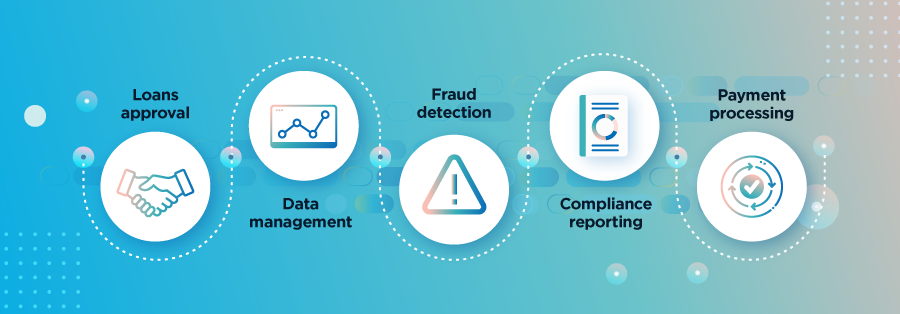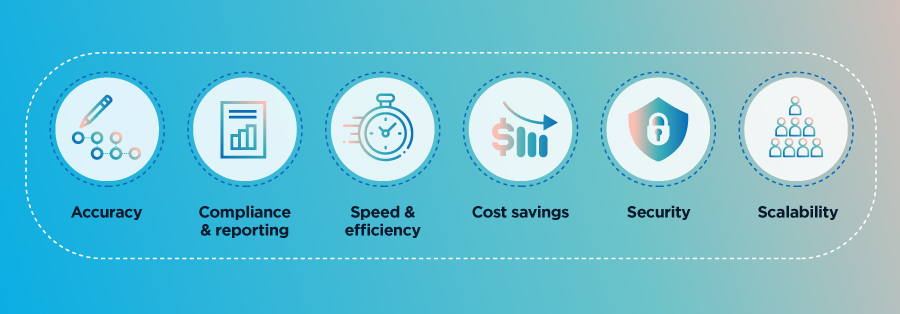How Automation Is Changing the Banking Industry

Like most industries, financial institutions are turning to automation to speed up their processes, improve customer experiences, and boost their productivity. Before embarking with your automation strategy, identify which banking processes to automate to achieve the best business outcomes for a higher return on investment (ROI).
These may include:
- Providing customers with the level of personalized service they expect
- Enabling employees to focus on higher-value tasks
- Simplifying customer onboarding for both parties
- Strengthening risk management and achieving flawless, cost-effective compliance
In this guide, we’re going to explain how traditional banks can transform their daily operations and future-proof their business. Bank automation helps to ensure financial sustainability, manage regulatory compliance efficiently and effectively, fight financial crime, and reimagine the employee and client experience.
What Is Banking Automation?
Automation software uses digital technologies such as intelligent automation (IA), which employs artificial intelligence (AI), machine learning (ML), robotic process automation (RPA), and business process management (BPM), among others, to automate tasks and end-to-end business processes within the financial services industry.
These processes can range from routine tasks to complex financial operations. The banking automation process increases efficiency, accuracy, and speed in carrying out tasks while reducing the need for manual processes. This leads to better resource allocation and cost savings.
What Are Banks Automating?
An IA platform deploys digital workers to automate tasks and orchestrate broader processes, enabling employees to focus on more subjective value-adding tasks such as delivering excellent customer support. Digital workers perform their tasks quickly, accurately, and are available 24/7 without breaks, and can aid human workers as their very own digital colleagues.
What are examples of banking automation?

The key areas where banks are utilizing automation technologies are:
- Customer service: There are many examples where IA can improve customer-facing processes, namely, with chatbots utilizing natural language processing (NLP). Chatbots can handle routine inquiries, provide preliminary account information, and even assist with simple transactions. This lets customers get their questions answered sooner and frees human agents to work on other tasks.
- Customer onboarding: Bringing new customers on board can be simplified with digital workers. They reduce paperwork by automatically digitizing and filling in information, ensuring data accuracy, and sending it to the right people within defined SLAs. This means new customers have access to their accounts sooner, in line with their expectations, and it enables banks to build customer loyalty from the very first interaction.
- Account management: Digital workers can help process transactions, automatically update individual customer information across data sources, and manage account balances – reducing the rate of errors and accelerating processes. As technology advances, intelligent automation can evolve in line with the development of new personalization options as they become available.
- Payment processing: IA can also help with e-transfers, wire transfers, direct deposits, etc., all while maintaining compliance and ensuring data security. And since it works without breaks or errors, processing times are faster and eliminate the risk and cost of error correction.
- Fraud detection and prevention: Suspicious activity could be easily missed by the human eye, but digital workers can automatically monitor transactions and flag unusual behavior. This helps banks take preventative measures against fraudulent activities and improves their reaction time. Plus, digital workers generate an audit trail of their processes for complete visibility.
- Loans approval: You can automatically process loan applications and evaluate credit scores to determine loan eligibility. IA can help with decision-making by providing clear insights into customer data and speeding up loan processing by enabling loan agents to do the important work they’re trained for. Loan automation and mortgage automation are both huge opportunities for financial institutions looking to increase efficiency and reduce manual effort so they can focus on better customer service.
- Data management: IA consolidates data from various systems to automatically generate reports, analytics, and data visualization dashboards. Banks can therefore gain access to real-time intelligence to assess performance and help people make more informed decisions based on deeper insights and respond faster to capitalize on opportunities and mitigate risks.
- Compliance and regulatory reporting: Automation tracks transactions, generate accurate and timely reports, and ensures banks are operating within their legal regulatory requirements through faster document processing time. KYC automation and AML automation can help financial institutions eliminate risk as digital workers follow the exact protocols they’ve been designed to follow and enable key-stroke-level auditing.
- Self-service: Customers are increasingly expecting broader self-service functionality, as they want immediate access to financial services, without risk. Automation enables customers to perform various transactions such as withdrawals, deposits, transfers, additional product applications, and inquiries – without any human interaction.
- Internal operations: Automation supports all front, middle, and back-office functions. IA can help with various internal operations including HR and payroll, workflow management, document routing, employee onboarding, treasury management, and more.
Who uses banking automation?
The goal of automation in banking is to improve operational efficiencies, reduce human error by automating tedious and repetitive tasks, lower costs, and enhance customer satisfaction. And by strategically implementing banking automation with a reliable operating business model, you can ensure the right processes are adopted in the best order to implement a scalable intelligent process automation ecosystem that grows with your business needs.
Intelligent automation already has widespread adoption throughout the financial services and banking industry. Find out how other banking organizations are building a roadmap to enterprise-scale in our intelligent automation survey.
What Are the Benefits of Banking Automation?

The financial services and banking industries are rife with archaic paper-based, manual, and multi-channel processes aiming to meet customer, regulatory, and business demands from a multitude of disparate systems and silos. It’s an industry that craves digital acceleration and transformation, and as such, intelligence automation offers the multitude of business benefits it so desperately seeks to achieve. These include:
Efficiency and speed
By eliminating manual processing of routine tasks like data entry, transaction processing, and account updates, automation speeds up operations and processing time, reduces human errors, and allows banks to handle higher volumes of transactions in a shorter timeframe – increasing their capacity and productivity.
Cost savings
By reducing manual tasks, banks can reduce their operational costs and reallocate their employees to higher-value work. IA also reduces human mistakes and enables an always-on operation, enabling digital colleagues to work sequentially or in tandem with human workers and resulting in greater efficiency, fewer reworks, and zero duplication of effort.
Accuracy
Automated systems are less prone to errors, which is crucial for mitigating risk in a highly regulated environment, where accuracy is critical to avoid financial losses, non-compliance penalties, and cyber security risks.
Consistency
Digital workers execute processes exactly as programmed, based on a predefined set of rules. This helps financial institutions maintain compliance and adhere to structured internal governance controls, and comply with regulatory policies and procedures.
24/7 availability
Digital workers operate without breaks, enabling customer access to services at any time – even outside of regular business hours. This helps drive cost efficiency and build better customer journeys and relationships by actioning requests from them at any time they please.
Improved customer experience
Customers receive faster responses, can process transactions quicker, and gain streamlined access to their accounts. IA helps speed up and improve responses to customer requests with personalized services including chatbot assistance, facilitating faster loan, credit, and credit card applications, fraud prevention, broader self-service options, mobile banking, digital onboarding, account information updates, closing accounts, and more.
Improved employee experience
Using IA allows your employees to work in collaboration with their digital coworkers for better overall digital experiences and improved employee satisfaction. They have fewer mundane tasks, allowing them to refocus their efforts on more interesting, value-adding work at every level and department.
Better security
IA ensures transactions are completed securely using fraud detection algorithms to flag unauthorized activities immediately to freeze compromised accounts automatically. Other IA capabilities to achieve better security include multi-factor and biometric authentication, continuous monitoring, data encryption, user access control, anti-money laundering (AML) compliance, real-time alerts, and quick incident response process orchestration and delivery.
Data analysis
Automation can gather, aggregate, and analyze data from multiple sources to identify trends enabling employees throughout the business to make more informed business decisions with deeper business intelligence insights. This may include developing personalized targeting of products or services to individual customers who would benefit most in building better relationships while driving revenue and increasing market share.
Scalability
Banks are susceptible to the impacts of macroeconomic and market conditions, resulting in fluctuations in transaction volumes. Leveraging end-to-end process automation across digital channels ensures banks are always equipped for scalability while mitigating any cost and operational efficiency risks if volumes fall.
Compliance and reporting
IA tracks and records transactions, generates accurate reports, and audits every action undertaken by digital workers. It can also automatically implement any changes required, as dictated by evolving regulatory requirements.
Competitive advantage
By embracing automation, banking institutions can differentiate themselves with more efficient, convenient, and user-friendly services that attract and retain customers.
What Is the Future of Banking Automation?

As the future of fintech advances and automation becomes increasingly integral to the financial services ecosystem, we’re already seeing the adoption of more technical complexity such as artificial intelligence (AI) and machine learning (ML) to undertake tasks that replicate more subjective work carried out by humans—resulting in more efficient workflows.
We see a future where IA enables the banking industry to run from a truly digitized core and catch up with the levels of operational speed, risk prevention, and personalization customers are already benefiting from across other industries.
Those institutions willing to open themselves up to the power of an automation program where they’re fully digitized will find new ways of banking for customers and employees.
The future’s looking bright. Learn more about digital transformation in banking and how IA helps banks evolve.
Key Takeaways
- The scope of banking automation is far-reaching across processes and departments
- Customers, employees, and financial institutions can all benefit from automation
- Automation reduces errors and improves processing time
- Use cases for banking and financial services automation are growing
- IA helps with risk mitigation and assessments for better security and auditability